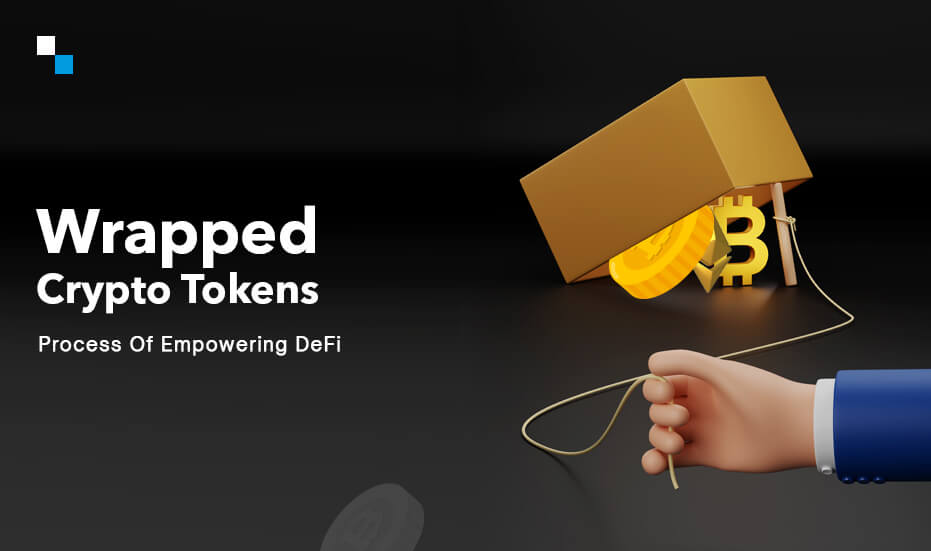In this rapidly evolving landscape of blockchain and cryptocurrencies, Wrapped token development solutions have emerged as a game-changer, bridging the gap between different blockchain ecosystems. Whether you are a seasoned crypto enthusiast or just dipping your toes into the world of digital assets, understanding Wrapped tokens is essential for navigating the DeFi space and unlocking a universe of opportunities.
In this blog, we will uncover the mysteries of Wrapped tokens to explore the reasons behind their growing popularity, their key roles, use cases, and future outlook in shaping the DeFi space.
Key Facts 👍
- Wrapped crypto tokens are managed by smart contracts that help to mirror the locked collateral of the underlying asset on an alternative blockchain.
- Their vital role lies in enhancing liquidity within the fast-growing DeFi ecosystem.
Understanding of Wrapped Token Development Solutions
In simple words, a wrapped token is a token that symbolizes another blockchain or token standard’s cryptocurrency and is worth the same as the original coin. The wrapped token, unlike the original cryptocurrency, can be utilized on non-native blockchains and later redeemed for the original coin.
One of the most significant advantages of wrapped tokens is that they increase interoperability between incompatible cryptocurrencies and blockchains, allowing for things like bitcoin lending or borrowing ether on DeFi platforms. Wrapped token development solutions increases the liquidity of decentralized services and increases the utility of crypto assets.
| “As of March 13, 2023, WBTC has a market capitalization of more than $10 billion USD. The token has exceptional liquidity, with daily trading volumes exceeding $1 billion USD on decentralized exchanges (DEXs) such as Uniswap and SushiSwap.” |
WBTC (Wrapped Bitcoin), is the pioneer stablecoin within the wrapped tokens framework. As an ERC20 token on Ethereum, WBTC is backed 1:1 by Bitcoin, granting dApps direct access to the Bitcoin ecosystem. Notably, WBTC doesn’t require any additional utility token and incurs no extra transfer fees apart from standard blockchain gas fees. With a simple federated governance model, WBTC strives to enhance usability across the decentralized landscape.
Pegged Tokens Vs. Wrapped Crypto Tokens
Pegged tokens and wrapped crypto tokens are both solutions to enable cross-chain compatibility and interconnectivity between different blockchain networks, but they differ in their underlying mechanics and use cases. Let’s compare them:
1. Definition
- Pegged Tokens: Pegged tokens are blockchain-native tokens that are directly backed or pegged to the value of a specific asset, such as a fiat currency (e.g., USD stablecoins like USDT, USDC) or a cryptocurrency (e.g., DAI pegged to the value of the US dollar).
- Wrapped Crypto Tokens: Wrapped tokens, on the other hand, are tokens representing assets from one blockchain network on a different blockchain. They are created by locking the original asset on its native blockchain and issuing an equivalent representation on the target blockchain.
2. Underlying Asset
- Pegged Tokens: The value of pegged tokens is usually maintained through mechanisms like collateralization or algorithmic stability mechanisms. For instance, a USD stablecoin may be backed by an equivalent amount of US dollars held in reserves or other assets with a stable value.
- Wrapped Crypto Tokens: Wrapped tokens are backed by the original asset held in reserve or through smart contracts on the native blockchain. For example, WBTC is backed by BTC held by custodians or through a decentralized network of nodes.
What are the key features of Wrapped Crypto Tokens?
Wrapped tokens are a safe and secure way of storing value. They have a wide range of key features that makes them outshine in the crypto market.
Key Features of Wrapped Crypto Tokens:
- Asset Representation- Wrapped Tokens are managed by smart contracts and mirror the value and characteristics of the original asset from a different blockchain. They act as representations or equivalents of the underlying asset.
- Cross-Chain Interoperability- These tokens enable seamless transfer and utilization of assets across different blockchain networks. They act as bridges, allowing assets from one blockchain to be utilized in applications on another blockchain.
- Increased Liquidity- By facilitating cross-chain interoperability, Wrapped Tokens enhance liquidity within the decentralized finance (DeFi) ecosystem. This increased liquidity benefits users and applications that require access to assets from multiple blockchains.
- Transparency and Auditability- Wrapped Token development solutions are often designed with transparency in mind. Many implementations allow users to verify the collateralization of the wrapped asset on the original blockchain, ensuring that the wrapped token is backed by the correct amount of the underlying asset.
- Decentralized Custodianship- These tokens rely on a network of custodians who are responsible for managing the collateralization and issuance of wrapped tokens. This custodianship is typically decentralized to avoid central points of control.
- Smart Contract Integrations: Wrapped tokens can be integrated into various smart contracts and dApps to create unique use cases. For example, they can be used to create synthetic assets, prediction markets, and more.
- Facilitating dApps- Wrapped Tokens allow decentralized applications (dApps) on one blockchain to gain access to and utilize assets from other blockchains, expanding the functionalities and possibilities for dApp developers.
- Yield Farming and Staking– Wrapped tokens can be used for yield farming and staking across different DeFi platforms. Users can stake wrapped tokens to earn rewards, boosting their engagement in the DeFi ecosystem.
Wrapped tokens designed by an experienced token development company are devoid of any smart contract vulnerabilities, making them a safe mode of transactions in cryptosphere. Therefore, it is always necessary to choose the right service provider, having years of expertise in blockchain technology to frame a secure and easy-to-use wrapped token.
Real World Examples of Wrapped Tokens
Wrapped token development is trending due to their potential to solve some of the biggest challenges facing the blockchain industry. As the DeFi ecosystem continues to grow and the demand for cross-chain trading increases, wrapped tokens are likely to become even more popular in the future.
- Wrapped Bitcoin (WBTC)- WBTC is one of the most prominent examples of a wrapped token. It represents Bitcoin (BTC) on the Ethereum blockchain as an ERC-20 token. WBTC enables Bitcoin holders to participate in DeFi platforms and other Ethereum-based applications while retaining exposure to the value of their Bitcoin holdings. WBTC is created through a consortium of custodians who lock up BTC in exchange for an equivalent amount of WBTC.
- Wrapped Ethereum (WETH)- Similar to WBTC, WETH is an ERC-20 token representing Ethereum (ETH) on the Ethereum blockchain. WETH is commonly used as a medium of exchange for liquidity provision on decentralized exchanges (DEXs) like Uniswap and other DeFi protocols.
- RenBTC- RenBTC is a cross-chain wrapped Bitcoin protocol that allows users to convert BTC into an ERC-20 representation of Bitcoin on the Ethereum blockchain. RenBTC relies on a decentralized network of nodes to facilitate the wrapping process.
- sUSD (Synthetix USD)- sUSD is a synthetic stablecoin on the Ethereum blockchain, part of the Synthetix protocol. It is created by locking collateral, such as ETH, into the Synthetix smart contracts. sUSD can then be traded and used in various DeFi applications.
- tBTC- tBTC is a trustless and decentralized wrapped Bitcoin protocol that mints an ERC-20 token, representing Bitcoin, on the Ethereum blockchain. Users can lock their BTC in a non-custodial manner, and the protocol ensures that the peg between BTC and tBTC is maintained through economic incentives and penalties.
The Final Thought
As the blockchain industry continues to grow, wrapped token development projects are likely to become even more popular. They have the potential to solve some of the biggest challenges facing the industry, such as the lack of interoperability and the need for greater security. In the future, wrapped tokens could become the standard way to transfer value between different blockchains.
Planning to develop wrapped crypto tokens? Shake hands with Antier! We are a leading Token development company with years of experience in the blockchain and cryptocurrency industry. Our seasoned subject matter experts design smart contracts to ensure the seamless wrapping of assets from one blockchain to another. We pledge to bring a wealth of technical expertise and industry knowledge to the token development process of creating wrapped crypto tokens, enabling efficient and secure cross-chain asset representation and enhanced liquidity in the DeFi ecosystem. Consult the experts, now!







